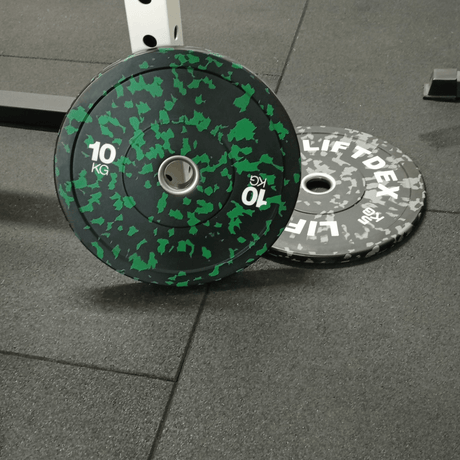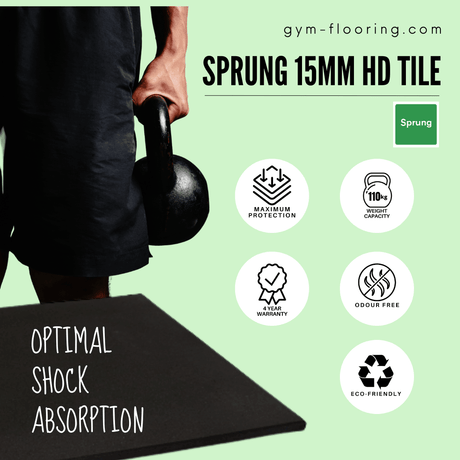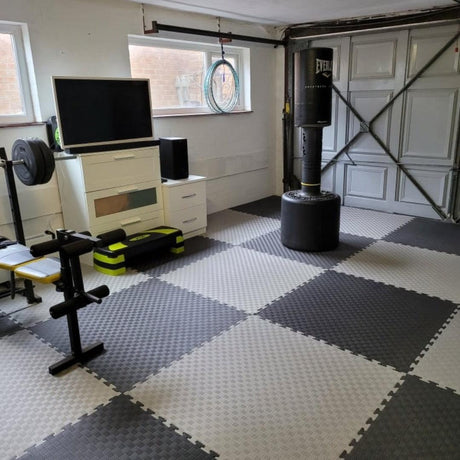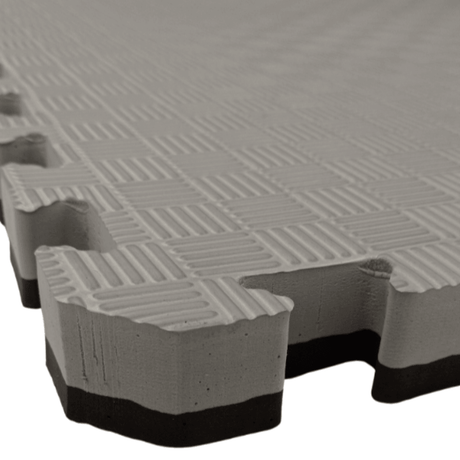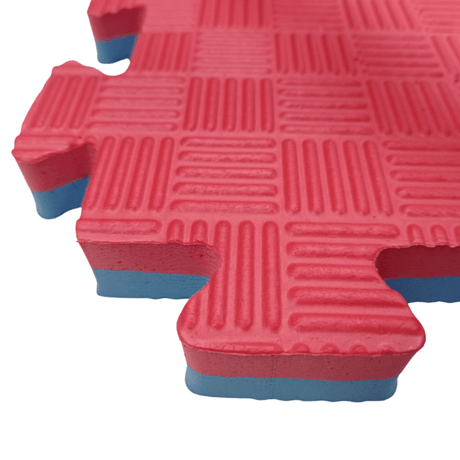Gym flooring has to endure alot - heavy traffic, dropped weights, spills and more – all while keeping you safe and comfortable.
In this guide we’ll look at the different materials used for gym flooring, their benefits and some practical tips to help you choose the right one for your space.
Table of Contents
What Are Gym Floors Made Of?

Most gym floors start with a solid subfloor, usually made of concrete or screwed down plywood. This base is then topped with a synthetic material such as rubber, vinyl, wood or foam flooring mats. In some cases the full composition of the floor is made of synthetic material such as urethane or rubber.
Despite the type of material, gym flooring must be:
- Durable: Able to withstand constant use, heavy weights and equipment.
- Easy to Maintain: Simple to clean and care for.
- Slip Resistant: Essential for preventing accidents during high intensity workouts.
- Shock Absorbent: Able to absorb impact from weights and intense exercise.
The choice of material mostly depends on the type of location, the main uses of the spaces and budget.
Popular Gym Flooring Materials
Here are the most widely used material for gym flooring:
Rubber Gym Flooring: The All Rounder

Rubber flooring is the favourite among gym owners – and for good reason. Its high durability and great shock absorption makes it perfect for areas where heavy lifting and high impact activities are common.
Here’s why rubber gym matting might be the perfect choice for your gym:
- Durable: Can handle heavy traffic and the constant impact of dropped weights.
- Slip Resistant: Provides a secure footing, reduces the risk of falls.
- Easy to Install: Rubber tiles or rolls can be installed relatively easily.
- Sound Absorption: Damps down noise in busy high intensity areas.
- Comfort: Cushions your feet and joints during long workouts.
- Safety: Cushions falls and minimises injuries.
With different thicknesses available, rubber flooring can be customised to suit different areas of your gym.
Wood Gym Flooring: A Classic Choice
For those who like a more traditional look, hardwood gym flooring is a popular choice in many gyms and sports centres. Here are some of its benefits:
- Low Maintenance: Easy to clean and maintain.
- Resilient: Can withstand heavy traffic and is designed to last.
- Refinishable: If signs of wear appear, hardwood can be sanded and refinished to look like new.
- Aesthetic Appeal: Looks timeless and classic.
If you’re considering hardwood for your gym, it’s best to consult a professional. Proper installation is crucial – especially if a sprung floor system is required – to ensure longevity and performance.
Vinyl Gym Flooring: Versatility at Its Best
Vinyl flooring made from PVC has many benefits that make it popular in fitness studios and sports facilities. Here are its key features:
- Customisable Designs: Available in various colours and designs such as stone and wood effect.
- Easy to Clean: Low maintenance and easy to care for.
- Impact Localisation: Its point elastic property means the impact is confined to the point of contact rather than spreading across the floor.
However, while vinyl is suitable for some fitness applications it may not be the best option for high-impact areas like weightlifting zones. Heavy equipment can damage vinyl and it offers less impact protection than rubber. Proper weightlifting gym mats are recommended for free weights use or particularly high impact workouts.
Foam Fitness Flooring: For Extra Comfort

Foam flooring mats are perfect for studios and gyms that host activities that require extra cushioning, such as MMA, boxing or gymnastics. Made from EVA foam, these tiles or provide a soft, high density surface that is both comfortable and safe. Here are its benefits:
- High Cushioning & Comfort: Reduces fatigue, so long training sessions are more comfortable.
- Impact Absorption: Excellent for high intensity and high impact activities.
- Flexible Layout Options: Can be configured as a temporary set-up or glued down for as a permanent floor solution.
- Versatile: Available in various sizes and colours to suit your design needs.
Synthetic Gym Grass: For Functional Fitness & Dynamic Workouts

Sled tracks, sprint lanes and artificial grass for gyms have become a staple in most contemporary gym spaces. These versatile surfaces provide the perfect surface for sled pushing, speed drills, CrossFit and other types of modern training. Here's why they are so popular:
- Good Traction: Provides a stable surface for exercises that require strong foot control such as plyometrics, speed training, agility and sled activities
- Slip Resistance: Prevents slips and falls during intense training
- Customisation: They can be personalised or matched to suit specific workouts and activities where the tracks are marked with lines, numbers or boxes for a dedicated workout space. Tracks can also be tailored made with branding and specific colours to suit a particular gym aesthetic.
Customer Feedback
"The track is excellent quality and looks great in our gym. Delivery was fast and your advisor was especially good with his recommendations. We'll definitely be using again."
Choosing the Right Gym Flooring for You
When choosing gym flooring, consider these key factors:

Conclusion
Choosing the right gym flooring is a big decision that impacts safety, performance and the overall look of your space. Whether you go for rubber’s durability, wood’s timelessness, vinyl’s versatility or foam’s comfort, consider the activities your gym will host, your budget and the long term maintenance requirements.
A well thought out gym floor not only enhances the training experience but also makes your investment last the daily use.
Ready to Upgrade Your Gym Flooring? Explore our range of Bestselling fitness flooring options. Alternatively, get in touch for some advice, recommendations or a Free Quote.
FAQs
What should I consider when choosing gym floor material for a home gym?
When choosing gym floor material for a home gym think about durability and compatibility with your workouts. For example, if you regularly lift weights you may want to opt for medium to heavy duty rubber tiles (between 20mm and above). On the otherhand, if you mostly do boxing training or martial arts, foam MMA mats would be a good match.
What are the differences between rubber tiles and rubber rolls?
Rubber rolls provide a seamless surface for large open spaces like spin studios. Rubber tiles allow for customisable layouts and often come in thicker options to support heavier equipment and weights.
Why are gym mats and high quality rubber flooring necessary for functional fitness areas?
They provide impact absorption, cushioning and a stable non slip surface. This is especially important for high intensity workouts with free weights and dynamic movements to ensure safety and performance.





